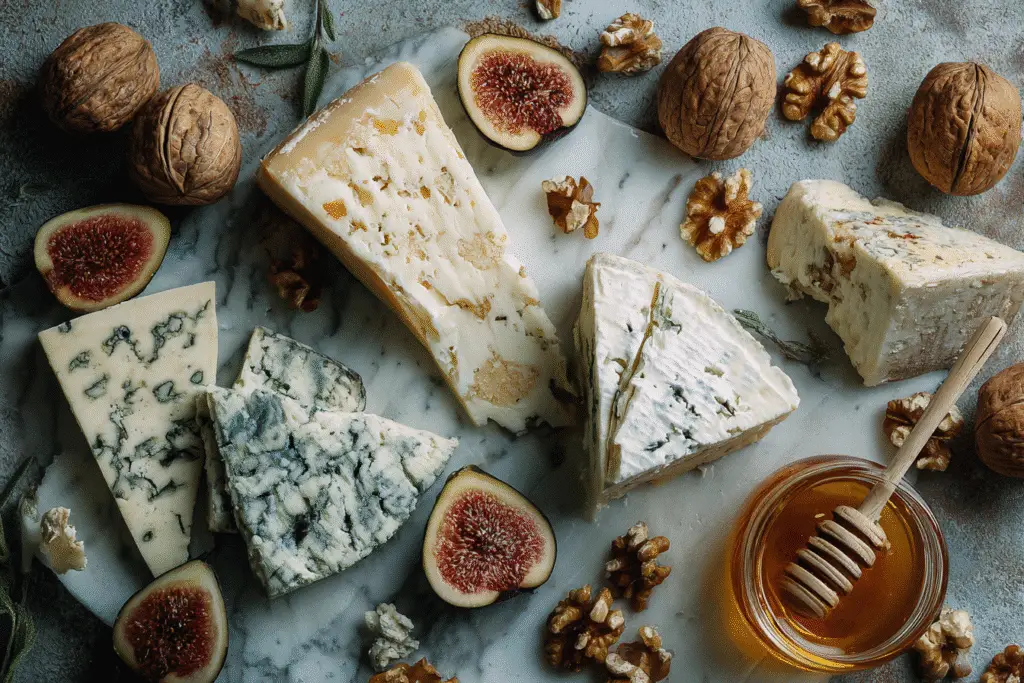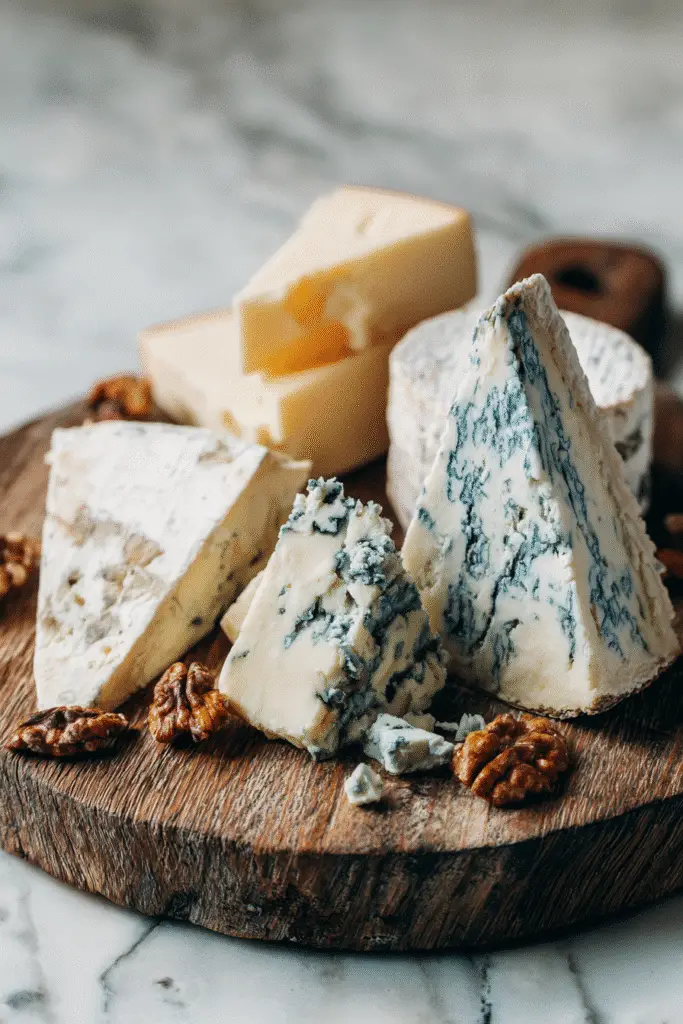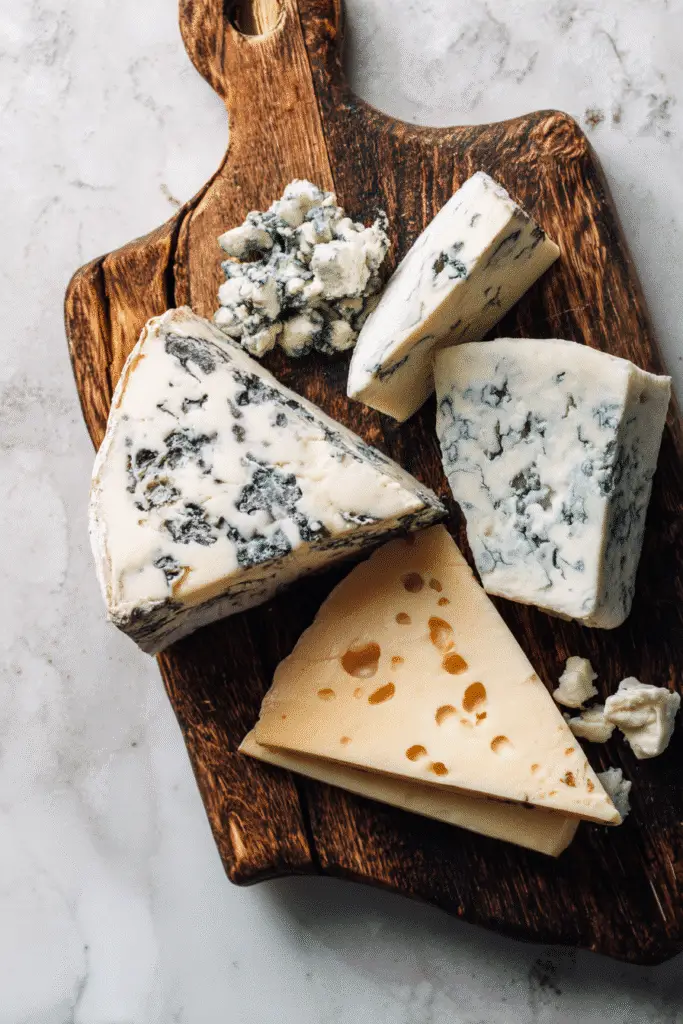Blue Cheese vs Gorgonzola—it’s a debate that’s puzzled cheese lovers at markets and dinner tables alike. Both share those striking blue-green veins and a tangy bite, but are they the same? Not quite. All Gorgonzola is blue cheese, but not every blue cheese is Gorgonzola—and the differences lie in their history, texture, and flavor.

I still remember standing at the cheese counter for the first time, staring at wedges labeled “Blue” and “Gorgonzola,” not sure which one to choose. My grandmother always had a piece of blue cheese on her Sunday platter, bold and salty, but when I finally tasted creamy Gorgonzola Dolce on warm bread in an Italian café, it felt like meeting blue cheese’s softer, sweeter cousin.
That’s the heart of the story: blue cheese is the broad, global family, while Gorgonzola is a proud Italian original with its own personality. In this guide, we’ll explore what makes each unique, when to use them, and how to choose the right wedge for your next meal.
Table of Contents
Sofia’s Story – From Confused Shopper to Confident Cheese Lover in 3 Months
Sofia Martinez, a 32-year-old teacher from Portland, Oregon, always felt overwhelmed at the cheese counter. “I saw labels like Blue Cheese and Gorgonzola, but I honestly thought they were the same thing,” she laughs. Whenever she planned a dinner party, she stuck to cheddar or brie—safe but predictable choices.
One weekend, while browsing recipes online, Sofia came across an article explaining the difference between Blue Cheese vs Gorgonzola. Curious, she picked up a wedge of Gorgonzola Dolce and a classic blue cheese to compare. The next evening, she built a small cheese board with walnuts, pears, and honey.
The experience was eye-opening. The blue cheese was bold, crumbly, and sharp—perfect crumbled over her salads. The Gorgonzola Dolce, on the other hand, was creamy, almost buttery, with a gentle tang that melted beautifully into risotto. Within a month, she found herself experimenting more in the kitchen, pairing cheeses with roasted vegetables, pastas, and even homemade flatbreads.
By the end of three months, Sofia was known among her friends as “the cheese board queen.” She could confidently explain the difference between a strong Roquefort and a sweet Gorgonzola Dolce, and her dinner parties had become a highlight. “It wasn’t about becoming a food expert overnight,” Sofia says. “It was about being curious, trying new flavors, and realizing that food has stories to tell. Now, instead of confusion, I feel excitement whenever I see Blue Cheese vs Gorgonzola on the shelf.”
Blue Cheese vs Gorgonzola: What’s the Real Difference?
- Warm intro with a storytelling hook (grandma’s cheese platter or market visit).
- Focus keyword Blue Cheese vs Gorgonzola appears in the opening line.
- Quick TL;DR answer (Google AI overview ready).
What Is Blue Cheese?
- Simple explanation of what blue cheese is.
- Flavor, aroma, and texture description.
- Mention how it’s used (salads, sauces, spreads).
- Include sensory details (crumbly, tangy, salty).
H2: What Is Gorgonzola?
- Short history of Gorgonzola (Italian origin).
- Unique characteristics vs other blue cheeses.
- Mild vs sharp taste depending on aging.
- Story-based touch: “I first tried Gorgonzola in a tiny trattoria…”
H2: Types of Gorgonzola
- Dolce (sweet, creamy, milder).
- Piccante (aged, sharp, crumbly).
- Comparison of uses in cooking (pasta vs steak vs cheese board).
- Sensory storytelling: imagine melting into risotto vs crumbling over salad.
H2: Can You Substitute Other Blues for Gorgonzola?
- Direct Yes/No answer.
- Mention Roquefort, Stilton, Maytag Blue.
- When substitution works (salads, dressings, sauces).
- When it doesn’t (Italian recipes with authentic flavors).

H2: The Bottom Line
- Simple recap: All Gorgonzola is blue cheese, but not all blue cheese is Gorgonzola.
- Encourage readers to try both, depending on flavor preference.
- Storytelling close: “My grandma always said, there’s a cheese for every mood.”
Blue Cheese vs Gorgonzola: What’s the Real Difference?
Blue Cheese vs Gorgonzola comes down to this—Gorgonzola is a specific Italian type of blue cheese, known for its creamy, milder flavor (Dolce) or sharper, crumbly version (Piccante). All Gorgonzola is blue cheese, but not every blue cheese is Gorgonzola.
If you’ve ever stood at the cheese counter, hesitating between those blue-veined wedges, you’re not alone. Blue Cheese vs Gorgonzola is one of those questions that sparks curiosity—and sometimes confusion. Are they the same thing? Which one is stronger? And more importantly… which one should land on your cheese board?
I still remember my first taste of blue cheese. It was at my grandmother’s Sunday table, where the platter always carried a wedge of something bold—crumbly, salty, and full of mystery. Years later, wandering through a small Italian market, I discovered Gorgonzola Dolce. Creamy, spreadable, almost sweet—it changed how I thought about blue cheese forever.
That’s the magic here: both blue cheese and Gorgonzola share that signature blue-green marbling, but their personalities couldn’t be more different.
What Is Blue Cheese?
Blue cheese is more than just a wedge with striking blue-green veins—it’s a whole family of cheeses created by introducing Penicillium mold during the aging process. This mold gives blue cheese its bold personality: tangy, salty, and just a little funky in the best way.
When you break into a piece of blue cheese, you’ll notice its crumbly texture and a pungent aroma that fills the air. Some varieties lean creamy and buttery, while others have a sharper, almost spicy edge. That’s why you’ll often see blue cheese crumbled over crisp salads, melted into steak sauces, or even spread across warm bread for a punch of flavor.
I still remember the first time I worked blue cheese into a dressing. The sharp tang swirled with cream, garlic, and herbs, and suddenly a simple bowl of greens tasted like something you’d find in a fine restaurant. It’s that ability to transform a dish that makes blue cheese unforgettable.
In short: blue cheese is a broad category, a whole world of flavors ranging from mild to bold, creamy to crumbly. And nestled within that world sits one of Italy’s most famous exports—Gorgonzola.
What Is Gorgonzola?
If blue cheese is the wide, colorful family, then Gorgonzola is its Italian cousin—the one with centuries of history and unmistakable charm. Born in the Lombardy and Piedmont regions of northern Italy, Gorgonzola is one of the oldest blue cheeses in the world, dating back nearly a thousand years.
What makes it special? For starters, its texture and flavor are deeply tied to how long it’s aged. Young Gorgonzola, known as Dolce, is soft, spreadable, and almost buttery with a gentle tang. Let it age longer, and you’ll meet Piccante, the stronger, sharper version that crumbles beautifully and packs a punch of savory intensity.
I still remember ducking into a tiny trattoria in Milan one rainy afternoon. The chef brought out a steaming bowl of risotto crowned with melting Gorgonzola Dolce. The creamy, earthy richness balanced by just the right salty bite—it was one of those dishes that stays with you forever. That’s the heart of Gorgonzola: comforting yet complex, rooted in tradition, and versatile enough to shine in both rustic and elegant dishes.
Unlike generic blue cheese, Gorgonzola carries the weight of its origin. It has a Protected Designation of Origin (PDO) in Europe, which means true Gorgonzola can only be produced in specific Italian regions using traditional methods. So when you taste it, you’re not just eating cheese—you’re tasting a piece of Italian heritage.
Types of Gorgonzola
When it comes to Gorgonzola, you’ll hear two names again and again: Dolce and Piccante. Both share the signature marbled veins of blue mold, but their personalities couldn’t be more different.
Gorgonzola Dolce
Dolce means “sweet” in Italian, and that’s exactly what this version delivers. Gorgonzola Dolce is aged for just a few months, giving it a soft, spreadable texture and a mild, creamy flavor. It almost melts across your tongue, with a subtle tang and a buttery finish that makes it perfect for spreading on fresh bread or whisking into a velvety sauce.
Imagine stirring a spoonful of Gorgonzola Dolce into warm polenta—it disappears like silk, leaving behind a delicate richness that feels both comforting and indulgent. It’s the kind of cheese that turns a simple meal into something soulful.
Gorgonzola Piccante
Now, if you’re in the mood for bold and unapologetic flavor, Piccante is your cheese. Aged longer—up to 12 months—it firms up into a crumbly wedge with sharper edges both in texture and taste. The flavor deepens, developing spicy, earthy notes that pair beautifully with hearty dishes.
Think of a juicy steak topped with melting Gorgonzola Piccante, or crumbles scattered over a roasted beet salad. The intensity cuts through richness and balances sweetness, making it a favorite for those who crave stronger flavors.
Both Dolce and Piccante showcase Gorgonzola’s versatility. Whether you want creamy comfort or bold punch, there’s a version waiting to elevate your dish—and both reflect the centuries-old craftsmanship that makes Gorgonzola so beloved.
Can You Substitute Other Blues for Gorgonzola?
Yes—but it depends on what you’re making.
Gorgonzola has a unique Italian character, but other blue cheeses can step in when needed. For creamy dressings or sauces, milder blues like Danish Blue or Maytag Blue can be excellent stand-ins. They melt smoothly and bring that tangy kick without overwhelming the dish.
If you’re craving intensity, Roquefort (from France) and Stilton (from England) are strong contenders. Roquefort is sharp and briny, with a salty punch that works beautifully on salads or crumbled over pears. Stilton, on the other hand, is more earthy and nutty, pairing well with hearty breads or even a drizzle of honey for contrast.
That said, not every swap captures Gorgonzola’s exact spirit. In traditional Italian recipes—like Gorgonzola risotto or creamy pasta sauces—the subtle sweetness of Dolce or the fiery edge of Piccante plays a role that’s hard to replicate. Substituting here won’t ruin the dish, but you’ll lose a touch of that authentic northern Italian charm.
So yes, other blue cheeses can fill in the gap, but if you’re aiming for the true Italian experience, nothing quite compares to Gorgonzola itself.
The Bottom Line
At the end of the day, all Gorgonzola is blue cheese, but not all blue cheese is Gorgonzola. Blue cheese is the wide world of bold, veined cheeses—each with its own punchy personality—while Gorgonzola is Italy’s proud contribution, celebrated for its creamy Dolce and sharp Piccante varieties.
So which should you choose? If you’re after something mild and luscious, spread Gorgonzola Dolce on warm bread or stir it into risotto. If you want something bold and unapologetic, reach for Gorgonzola Piccante—or experiment with Roquefort and Stilton for even stronger flavors.
For me, the beauty lies in the journey. My grandmother’s Sunday table taught me the joy of discovery with blue cheese, and that little trattoria in Milan showed me the soul of Gorgonzola. Every bite of these cheeses tells a story—of place, of tradition, of boldness balanced by comfort.
So next time you’re standing at the cheese counter, don’t overthink it. Try them side by side. Taste their differences. You might just find that there’s a blue cheese for every mood—and a Gorgonzola for every memory.

Conclusion
When it comes to Blue Cheese vs Gorgonzola, the difference isn’t just technical—it’s emotional, cultural, and culinary. Blue cheese as a family is bold, tangy, and adventurous, while Gorgonzola carries the heart of Italy, offering both the gentle creaminess of Dolce and the robust punch of Piccante.
What matters most is how these cheeses make you feel at the table. A dollop of Gorgonzola stirred into risotto can bring the comfort of a rainy Milan afternoon. A crumble of Stilton or Roquefort can turn a simple salad into something daring and unforgettable.
My grandmother used to say, “There’s a cheese for every mood, and a mood for every cheese.” And she was right. Whether you’re craving creamy, subtle notes or bold, tangy drama, there’s a wedge waiting to be discovered.
For more healthy recipes and drinks follow Sofie Recipes on Facebook and Sofie Recipes on Pinterest
FAQs
Is Gorgonzola stronger than blue cheese?
It depends. Gorgonzola Dolce is milder and creamier than many generic blue cheeses, while Gorgonzola Piccante can be just as sharp—or even stronger—than Roquefort or Stilton. The strength comes down to aging and the specific type of blue cheese.
What’s healthier: blue cheese or Gorgonzola?
Both are nutrient-rich, offering calcium, protein, and gut-friendly molds. The main difference is subtle—calorie and fat content are similar, but Gorgonzola Dolce may feel lighter due to its creamier texture. If you’re watching sodium, keep in mind that all blue cheeses tend to be salty.
Can I use Gorgonzola instead of blue cheese in recipes?
Yes! The blue-green mold in both blue cheese and Gorgonzola is a safe, edible strain of Penicillium. It gives the cheese its distinctive flavor and is completely safe to eat. Unlike harmful molds, this one is intentionally added during production.
